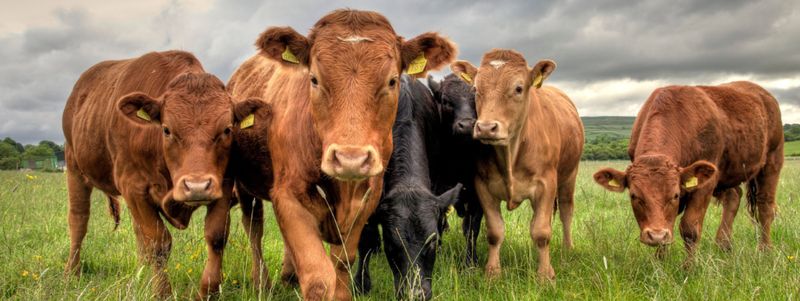
Published in Market Analysis
EU Meat Prices: Policy Driven Inflation Leads to Permanently Higher Prices
A Strategic Guide for Buyers, Producers, and Traders in a Structurally Constrained Market

As we move towards 2026, the European meat market is undergoing a significant structural change. The dynamics that defined previous decades are shifting, and it's important for all market participants to understand the new landscape.
This isn't a temporary spike driven by input costs. In fact, feed wheat and maize prices are down over 14% year-on-year. The current market is being reshaped by more permanent, structural supply constraints.
A "Great Divergence" is becoming clear. While the UN's global food price index for cereals and oils has declined, its Meat Price Index reached a new record high in September 2025. The EU market is at the centre of this trend, establishing a new, higher price floor.
Here is an analysis of what you need to know about each sector.
🥩 The Beef Sector: Adjusting to a New Supply Level
The EU beef sector is a clear example of this supply shift. This is not speculation; it is a statistical reality.
Elevated Prices: As of October 2025, prices for adult male bovine carcasses have reached historic highs, showing a significant +31.4% increase compared to last year.
The Driver: This is linked to a steady, long-term decline in the EU's cattle herd. The total bovine population fell by 2.8% in the last year, with major producers like Germany (-2.7%), France (-2.4%), and the Netherlands (-3.9%) all seeing reductions.
Crucially, this herd contraction is continuing despite these record-high prices. In a typical market, such high prices would encourage expansion. The fact that the opposite is happening suggests the market is responding to other, non-economic pressures.
Regulatory headwinds, including new environmental and animal welfare standards, are a key factor. This creates a challenging environment for investment and expansion.
The takeaway: The beef supply deficit appears to be a long-term structural feature, creating a durable need for imports to meet consistent EU demand.
🐖 The Pork Sector: A New Equilibrium and Trade Headwinds
The pork market has moderated from its 2023 peaks but has settled into a new, high-priced equilibrium, remaining well above the 5-year average.
The long-term trend also points towards a constrained supply. The EU's breeding sow population is down 3.5%, which forecasts lower production ahead. This is driven by similar regulatory pressures as beef, compounded by the persistent "major risk factor" of African Swine Fever (ASF).
On top of these domestic challenges, the sector faces new external trade friction. In September, China imposed preliminary anti-dumping duties on EU pork. This move introduces significant uncertainty for producers who rely on this key third-country market, potentially redirecting volume back into the EU.
🐔 The Poultry Sector: Recovery Meets New Volatility
Poultry has been the key alternative for consumers, helping to balance the market. Production was forecast to grow by 1.8% in 2025 to meet this "robust consumer demand."
However, this recovery is now facing significant new risks.
A new wave of Highly Pathogenic Avian Influenza (HPAI) was reported in October and November 2025. Outbreaks have been confirmed in several countries, including major producers like Germany, Poland, and Spain.
This is a developing situation that threatens to disrupt the supply of the EU's most affordable protein. It introduces fresh volatility into a market that was providing stability, putting pressure on a key protein source for many consumers and processors.
📈 How Meat Borsa Helps You Navigate This New Reality
This new market, defined by supply constraints and divergent volatility, requires smart, flexible tools. Here are practical examples of how producers, buyers, and traders can use the Meat Borsa platform.
For Producers
In a market with new trade barriers and domestic pressures, accessing a wide, reliable customer base is essential.
Example: A pork producer facing new export tariffs for a major non-EU market needs to pivot. They can use the Meat Borsa platform to list their available volume, instantly reaching hundreds of verified buyers within the EU and securing stable, new contracts to protect their business.
For Buyers (Processors & Retailers)
Your primary challenge is ensuring supply chain continuity and managing costs.
Example: A food processor sees reports of HPAI in their regular supply region. They can immediately use Meat Borsa to issue an urgent tender to a network of vetted suppliers, sourcing alternative volume from an unaffected area to prevent a production halt and maintain service to their customers.
Example: A retailer's procurement team, facing high domestic beef prices, can use the platform's data to transparently analyse import options. They can filter for EUDR-compliant (deforestation-free) suppliers from approved countries, compare landed costs, and build a more resilient, multi-source procurement strategy.
For Traders
Your role is to manage risk and find opportunity in the market's new structure. This requires speed and intelligence.
Example: A trader identifies the widening price gap between EU beef and global prices. They use Meat Borsa to efficiently source, negotiate, and manage logistics for beef imports from approved non-EU countries, helping to fill the structural deficit that EU policy has influenced.
Example: By monitoring HPAI alerts on the platform, a trader can anticipate regional supply tightening. They can secure poultry volume from a supplier in an unaffected "cold" zone and offer it to buyers in impacted "hot" zones, providing critical liquidity and stability to the market.
This new era of elevated prices and structural supply shifts is the new normal. The operators who thrive will be those who replace old assumptions with real-time data and a more agile, networked approach to procurement.
Source Attribution
This analysis is based on a synthesis of publicly available data and market reports from Q3 and Q4 2025. Key sources include:
The UN Food and Agriculture Organization (FAO): For global commodity trends, including the Food Price Index and Meat Price Index.
The European Commission: For EU-specific market dashboards, Short-Term Outlooks (Summer 2025), and the Medium-Term Outlook (to 2035).
Eurostat: For official EU livestock population and agricultural statistics.
OECD-FAO: For the long-term Agricultural Outlook 2025-2034, providing a global benchmark.
National & Industry Bodies: Including USDA, AHDB, and EFSA for specialised forecasts and animal health reports.
